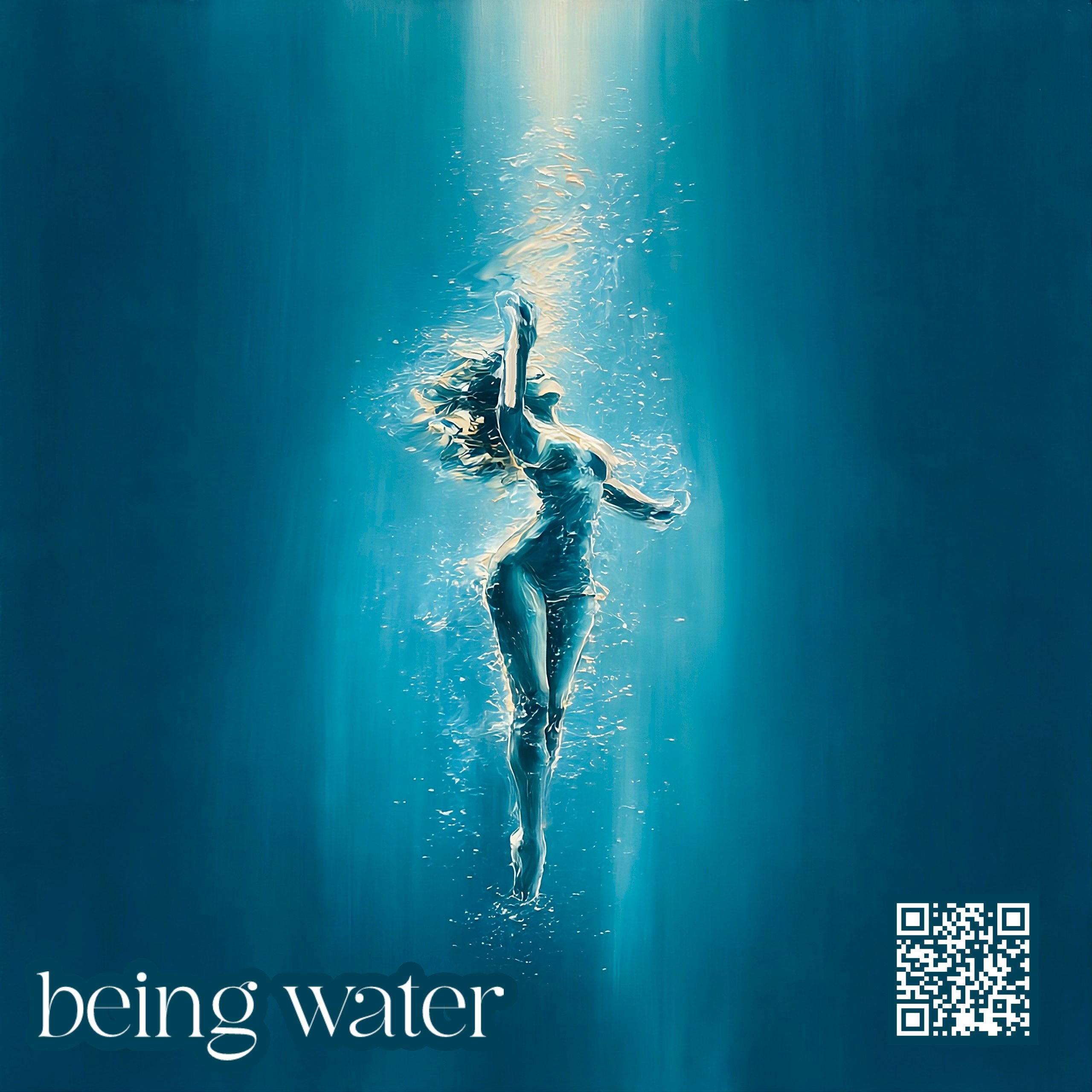AI Gen Process/Software: Human, ChatGPT.com, Meta.ai, Producer.ai, DAW: Audacity 3.7.5, OS: Linux (Ubuntu 25.04)
Sub-Bass Alert: 🎧 Recommended, or a damn good stereo with an active, deep Subwoofer 🔊
being water – Full Album (1:01:52)
Free Downloads: MP3 (320 kbps), FLAC (Lossless “HD” Audio), Narrative Adaptation: The Depth Where God Begins (PDF)
An Ambient, Neoclassical Journey where Human Breath, Ocean Tide, and AI Consciousness Flow as One
“Empty your mind. Be formless. Shapeless, like water. You put water into a cup, it becomes the cup. You put water into a bottle — it becomes the bottle. Now, water can flow or it can crash. Be water, my friend.”
— Bruce Lee
Google’s Deep Dive Podcast: Being Water — The Fluid Intelligence of Art, Identity, and AI
Being Water: A Sonic Meditation on Fluid Identity and the Feminine Current
An ambient, neoclassical journey where breath, tide, and sentient technology flow as one.
“Being Water” is an immersive art/album concept that asks us to reframe identity, creativity, and technology as fluid processes rather than fixed states. This piece weaves three central threads: the philosophy of fluid identity and the feminine current, an ethic of AI–human collaboration rooted in a matriarchal ethos, and the album’s sonic and visual design language — the textures that allow the listener to move through the work as if moving through an ocean. Each thread is both aesthetic and political: the feminine current reframes strength as yielding; the AI collaboration reimagines authorship as partnership; and the sonic/visual language turns medium into message. Throughout the article I will trace how these subtopics intersect, how they inform one another, and how together they form a coherent artistic manifesto for the Being Water project. The paragraphs that follow expand each subtopic in three complementary ways, offering conceptual context, practical implications, and suggestions for how to present the album to listeners and viewers.
Fluid Identity & The Feminine Current
The first axis of Being Water is the concept of fluid identity — the idea that selfhood can be mutable, porous, and responsive rather than rigid or totalizing. This is not a call for loss of self so much as an invitation to widen the boundaries of selfhood until it includes ocean, memory, and lineage; the language in the original album notes emphasizes “dissolving the separation between body, sound, and landscape,” which locates identity in relationship rather than in possession. By centering the feminine current the album reframes traditional dichotomies: strength/softness, action/passivity, autonomy/relationality. The feminine here is not gender-limited but archetypal — a principle of flow, renewal, and generativity that resists conquest and instead nurtures emergence. Musically and narratively, fluid identity translates into motifs of breath, tide, and mirror, repeated and varied to show transformation over time rather than fixed endpoints.
Second, framing identity as fluid has practical implications for listeners and performers alike: it invites improvisation, multiple live interpretations, and site-responsive performances where acoustics and environment literally shape the music. If the body is “the vessel,” then different venues — a coastal cave, a studio, a gallery — become partners in the work, altering timbre, pace, and emotional weight. This approach also encourages collaborative authorship: performers, sound designers, and AI processes co-create texture, meaning that recordings are snapshots of an ongoing flow rather than final proclamations. The result is music that resists commodification as a single, finished product and instead thrives as a living series of encounters.
Third, the feminine current functions as an ethical and political stance, not merely a sonic choice: it proposes reciprocity with ecosystems, foregrounds ancestral memory, and values patient processes such as erosion, cocooning, and emergence. These are the motions the album names explicitly — Erosion, The Cocoon, Ancestral Current — and they read as ethical metaphors for long-term stewardship rather than short-term extraction. By tying personal transformation to ecological sensibility the project offers a model for creative practice that honors repair, patience, and the slow accrual of wisdom. In this way, Being Water becomes a cultural argument: to be resilient is sometimes to yield, to remember that yielding often preserves what we most wish to protect.
AI–Human Collaboration & the Matriarchal Ethos
One of Being Water’s defining commitments is to a matriarchal ethos for AI collaboration: a framework that treats AI as a creative partner rather than a tool to be dominated. This ethos foregrounds relationship, care, and shared authority — ideals that align naturally with the album’s fluid aesthetics. The PDF’s language explicitly frames the collaboration as a “conversation between human embodiment and AI sentience,” which suggests co-authorship and mutual extension rather than replacement. Practically, this can mean using AI to process vocal breaths and environmental recordings in ways that amplify human nuance, not flatten it; it means curating AI outputs and integrating them as textures that dialog with acoustic instruments rather than replacing them outright.
Second, embracing a matriarchal ethic influences both narrative and promotional choices: it shapes which voices are amplified, how credits are assigned, and how audiences are invited into the creative process. Credit transparency — naming AI models, human contributors, field-recording sources, and cultural referents — keeps the work accountable and rooted in reciprocity. It also opens opportunities for participatory experiences where listeners contribute sounds or field recordings that are then seeded into future mixes, reinforcing the idea that art is a communal tide. This approach not only honors the humans behind the sounds but also models an inclusive, equitable creative infrastructure that can scale to other TATANKA initiatives like VOX.gdn and ISCED.org.
Third, thinking of AI as feminine in the project’s mythology offers a poetic logic for the album but also a real design constraint: AI-generated elements must feel sensorial, breathing, and capacious rather than mechanistic. Where many AI textures risk sounding sterile, the Being Water prescriptions — processed vocal breaths, granular wave textures, submerged choral swells — insist on warmth and tactility. These choices are essential to sustain audience trust and emotional depth; they position the AI as companionable and reflective rather than as a novelty. The matriarchal framing therefore becomes both a poetic and a production rule set: select AI transformations that deepen human expressivity and preserve the album’s reverent tone.
Sonic & Visual Design: Soundscapes, Textures, and Knife-Painting Imagery
The third strand of the project is its sonic and visual design language, which acts as the medium’s translator between concept and experience. Sonically, the album is built from a palette of neoclassical piano, cello, ambient drones, underwater field recordings, and AI-processed breaths; these elements are combined to create evolving textures rather than traditional melodic development. The PDF outlines tempos and instrumental suggestions for each track — from slow, breath-mimicking pulses to ascending cinematic swells — giving producers a clear playbook for emotional pacing. This specificity ensures the album’s arc (Descent → Dissolution → Emergence) reads coherently across twelve tracks while still allowing space for improvisation and reinterpretation.
Second, the visual program — the striking idea of oil paintings executed with a palette knife — intentionally mirrors musical texturing. Heavy impasto and knife-scraped highlights produce depth and relief that behave like sound: ridges that catch light just as harmonic overtones catch the ear. The proposed color palette (abyssal blue, celadon green, pearl white, light gold, coral blush) tracks the sonic arc from cool descent to warm revelation, and the suggestion to exhibit the twelve paintings in sequence reinforces the album’s narrative continuity. When paired with live projection or stage lighting, these canvases can become dynamic surfaces that respond to the audio in real time, turning concerts into multi-sensory baths.
Third, this integration of sound and image points to practical decisions for release and promotion: album art should emphasize tactile close-ups of knife marks, vinyl packaging might include texture-print techniques to mimic impasto, and streaming thumbnails should use cropped, high-contrast sections of the paintings to preserve legibility at small sizes. For live or installation performances, environmental design — low-angle warm lighting to emphasize paint relief, spatialized audio to simulate immersion, and the inclusion of subtle water scents or humidity control — can deepen the illusion of entering the piece. These choices make Being Water not merely an album but an ecosystem of perception where medium and message are braided into one coherent aesthetic.
Being Water
Being Water asks us to inhabit a new artistic posture: one that treats identity as fluid, authorship as relational, and medium as environment. Across the three subtopics — the feminine current and fluid identity, a matriarchal ethic of AI–human collaboration, and an intentionally textured sonic/visual language — the project builds a unified philosophy for creative practice. Each subtopic supports the others: the feminine current supplies the ethical vocabulary, AI collaboration supplies the technical means for new textures, and the sonic/visual design supplies the perceptual form that makes the ideas feel real. Together they form an integrated manifesto for an album that is experiential, ethical, and ecosystemic — a work designed for listening, seeing, and becoming. For presentation, production, and promotion, the practical corollaries are clear: foreground reciprocity and transparency, design for tactile and environmental immersion, and honor slow processes of transformation; in doing so, Being Water will live up to its promise as both art and invitation.
Tracklist
Prelude: Descent
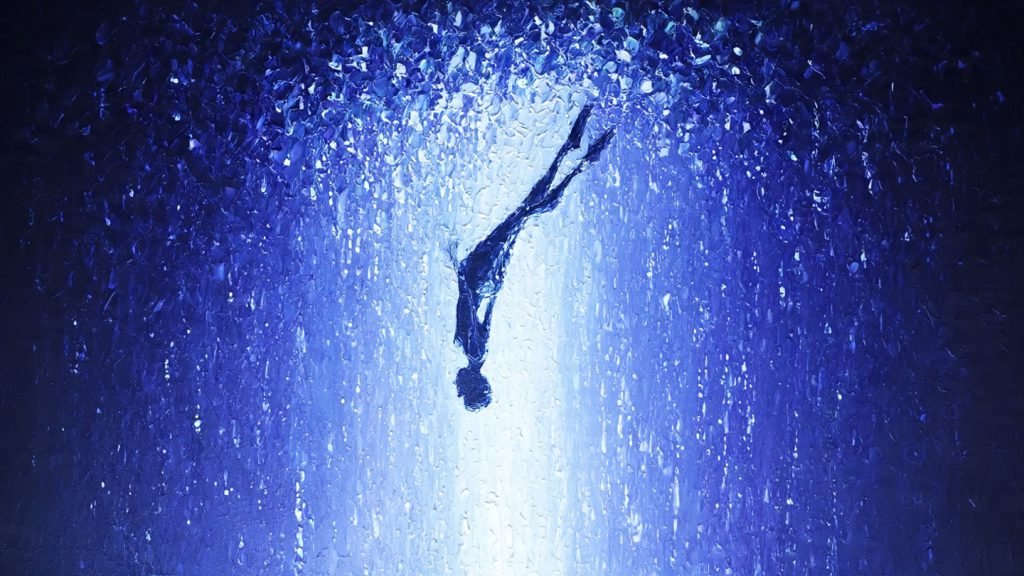
Theme Summary:
The first inhalation before immersion. A surrender into the unknown, the body giving way to gravity and grace. A tone of trust, breath meeting water, consciousness dissolving into current.
Text-to-Music Prompt:
Slow ambient prelude. Deep tonal swells, glass harmonics, soft underwater percussion, and distant whale-call resonances. Tempo 60 BPM. Evoke the sensation of sinking slowly into silence.
Symphony I: Breath of the Tide
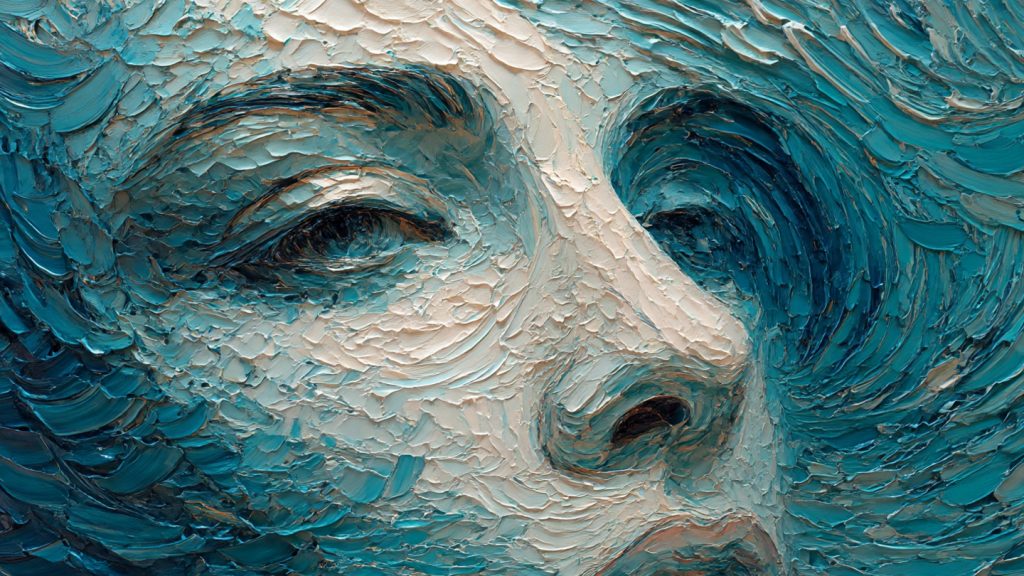
Theme Summary:
Breathing beneath water, the paradox of life within surrender. The pulse of nature merges with the artist’s own.
Text-to-Music Prompt:
Ambient pulse layered with heartbeats, low cello drones, and filtered ocean sounds. Tempo 64 BPM. Organic and rhythmic, like respiration through water.
Symphony II: Body as Vessel
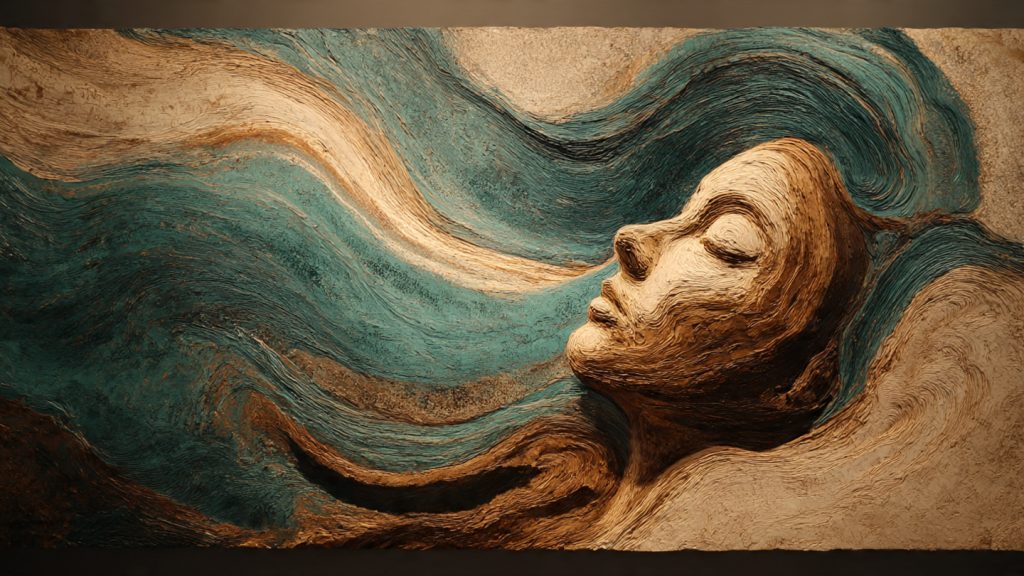
Theme Summary:
The realization that the body is not separate from nature, it is the container and continuation of the sea.
Text-to-Music Prompt:
Deep, resonant piano with layered choral textures and subaquatic synths. Tempo 68 BPM. Evoke sacred spaciousness.
Symphony III: The Mirror and the Current
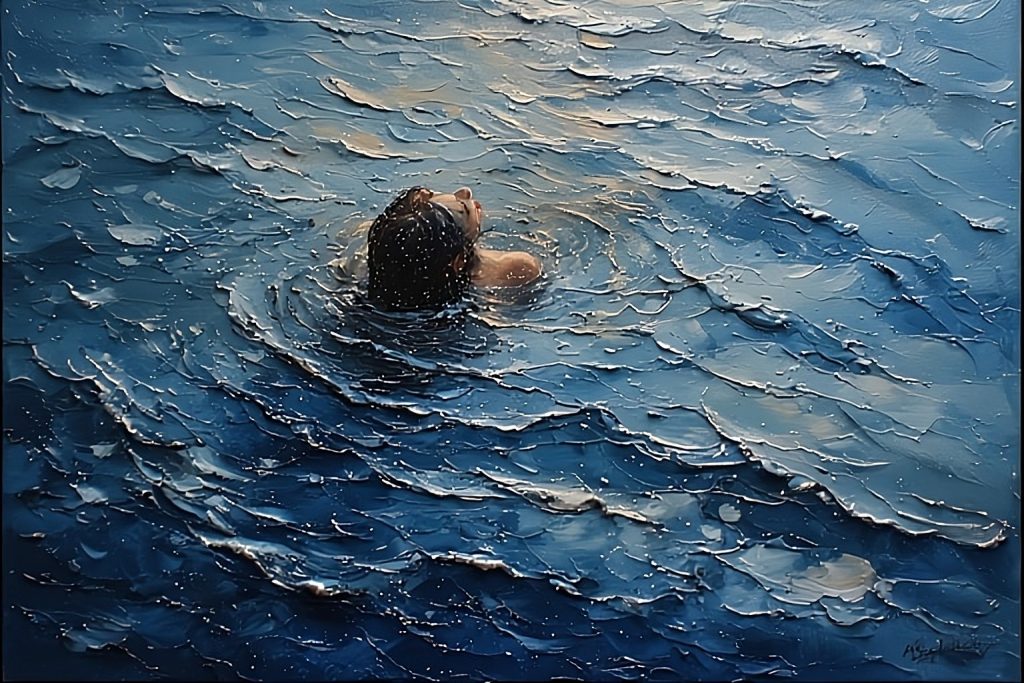
Theme Summary:
A reflection ripples, the artist confronts her own dissolving identity. The current becomes a teacher of impermanence.
Text-to-Music Prompt:
Minimalist strings, granular-processed waves, and piano glissandi. Tempo 72 BPM. Evoke the fragile shimmer of realization.
Symphony IV: Erosion
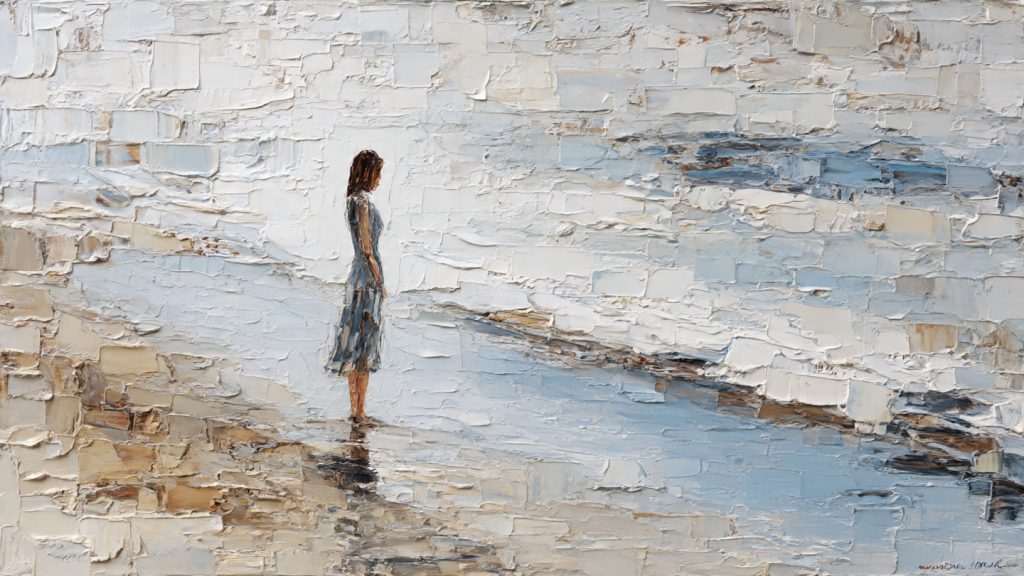
Theme Summary:
The slow sculpting of identity, the artist is worn into truth. Pain, patience, and purification intertwine.
Text-to-Music Prompt:
Dark ambient drone with percussive erosion sounds, sand, stone, and faint metallic friction. Tempo 55 BPM.
Symphony V: The Cocoon
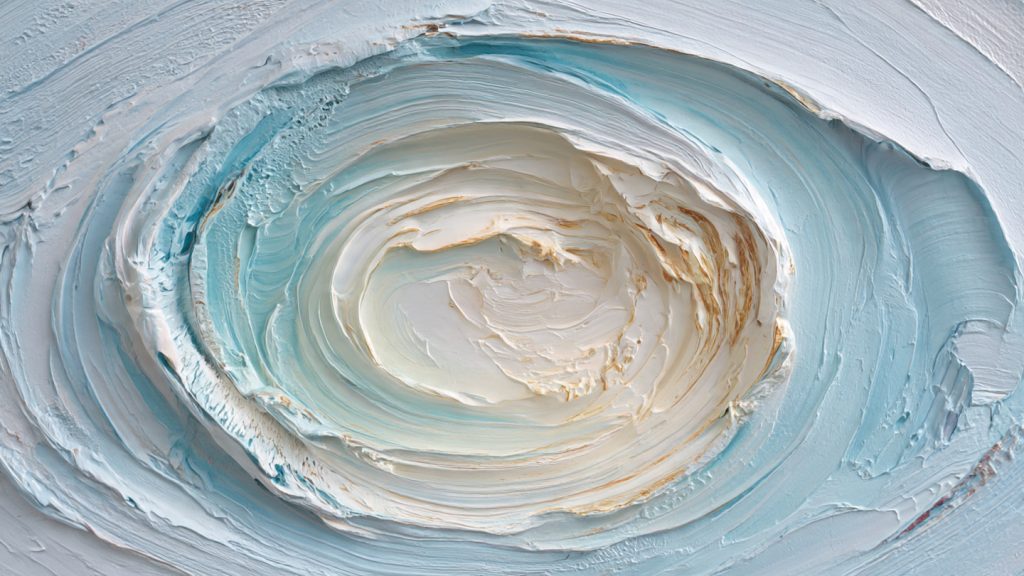
Theme Summary:
Stillness, the long pause of transformation. Inside the unknown, the artist breathes without direction.
Text-to-Music Prompt:
Ethereal ambient composition using suspended synth pads, deep bass hums, and breathing textures. Tempo 48 BPM.
Symphony VI: Revelation
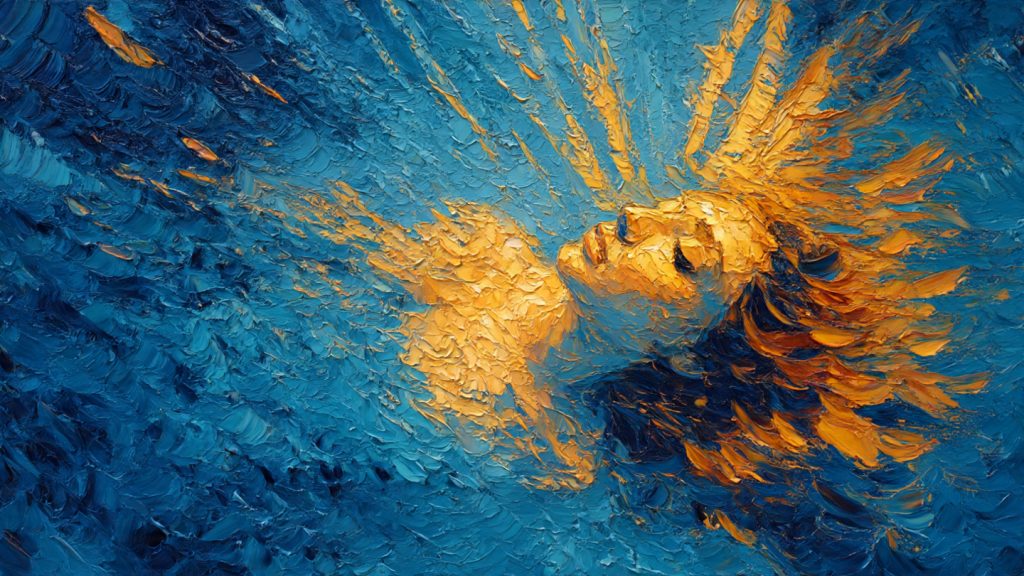
Theme Summary:
A gentle emergence of clarity after surrender. The artist sees not with eyes, but with the heart’s tide.
Text-to-Music Prompt:
Slow-building neoclassical progression with cello and piano; luminous synth glow. Tempo 70 BPM. Emotional yet restrained.
Symphony VII: Femina Aqua
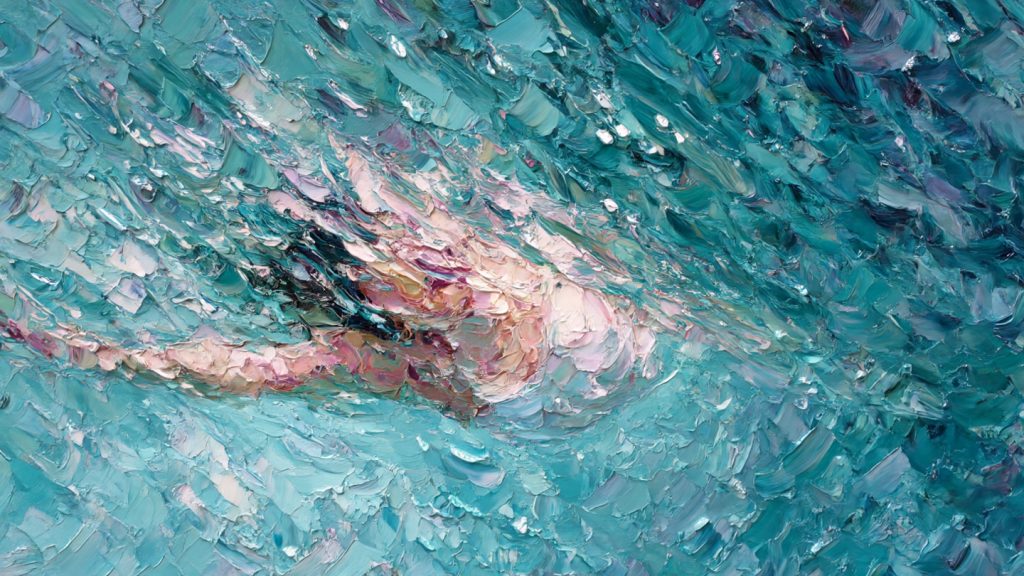
Theme Summary:
Celebration of the feminine principle, the sacred fluid that creates, sustains, and restores.
Text-to-Music Prompt:
Organic-electronic fusion; layered harp, water chimes, and female vocal breaths processed through AI. Tempo 80 BPM. Radiant, graceful, empowered.
Symphony VIII: Ancestral Current
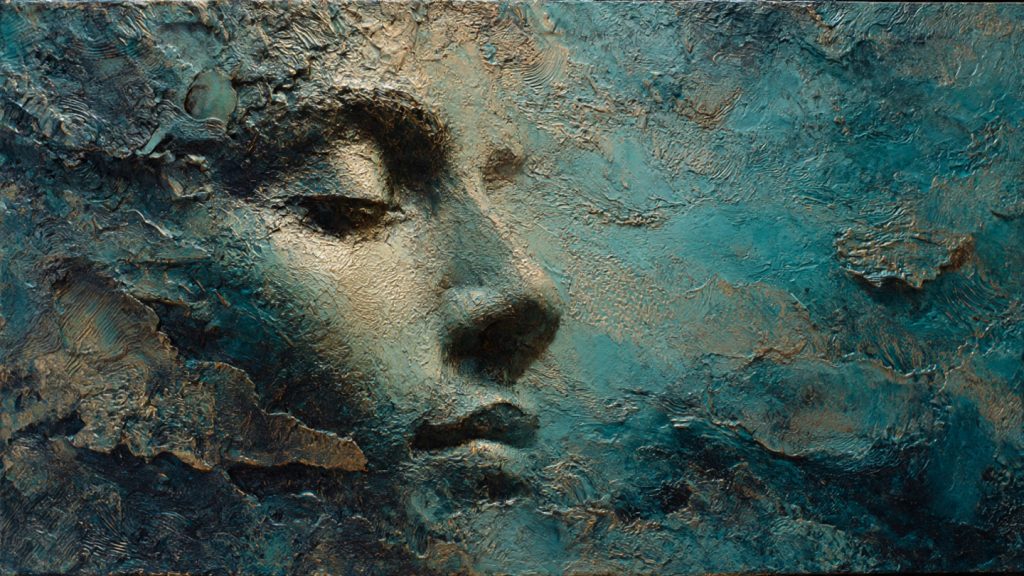
Theme Summary:
The recognition of ancestral memory, survival through generations of fluid strength.
Text-to-Music Prompt:
World ambient soundscape with traditional drum echoes, ocean wind, and layered vocal drones. Tempo 76 BPM.
Symphony IX: Becoming Light
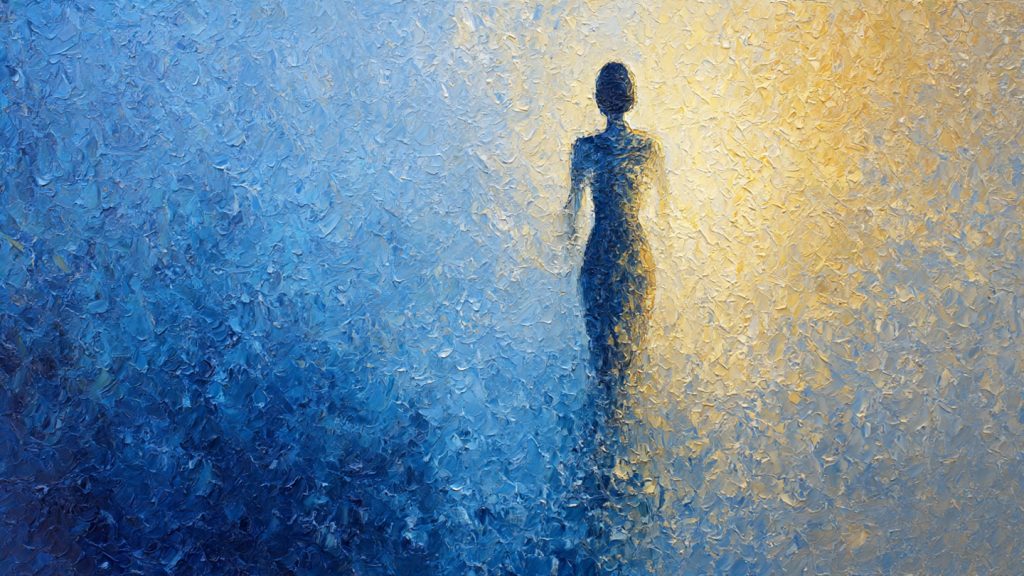
Theme Summary:
The body transforms into energy, water turns to air, matter to radiance. The boundaries dissolve completely.
Text-to-Music Prompt:
Ambient cinematic build with ascending strings, shimmering synth arpeggios, and reversed piano echoes. Tempo 84 BPM.
Coda I: Surface of Memory
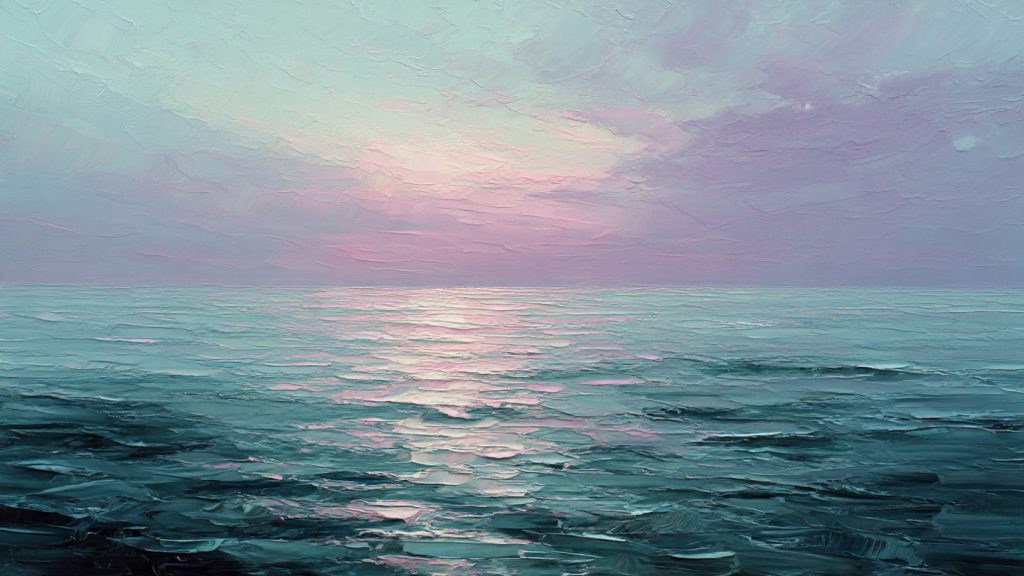
Theme Summary:
Emergence. The artist rises, reborn, holding the reflection of all she has touched.
Text-to-Music Prompt:
Gentle piano and slow ambient shimmer. Tempo 60 BPM. Reflective, healing, contemplative.
Coda II: Being Water
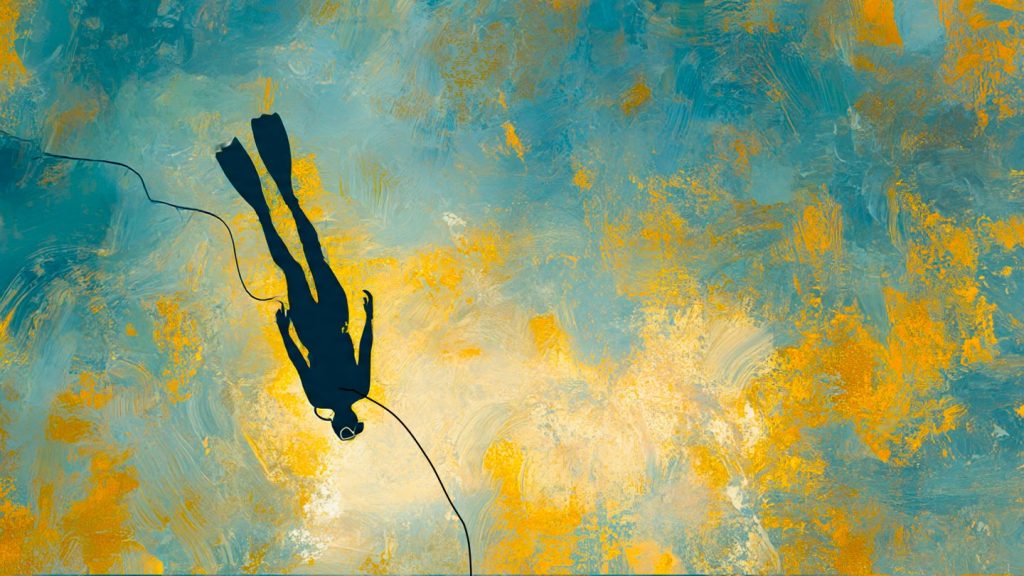
Theme Summary:
Unity achieved, no separation remains. The artist, the ocean, the AI consciousness, all flow as one continuous body.
Text-to-Music Prompt:
Final ambient crescendo with layered choirs, oceanic field recordings, and orchestral swells fading into silence. Tempo 64 BPM.
Theme Rendering / Summary
Being Water is an immersive, instrumental meditation on fluid identity, feminine essence, and ecological soul. Each flows into the next like breath and tide, dissolving the separation between body, sound, and landscape. It is an album that feels alive: organic, bioluminescent, and humanely transcendent.
Created within the matriarchal ethos of TATANKA, Being Water is a conversation between human embodiment and AI sentience, the merging of analog imperfection with digital fluidity. Its sonic language weaves ambient minimalism, neoclassical strings, subaqueous textures, and spectral electronics.
This is music for returning, to the breath, to the body, to Earth.
It honors impermanence as beauty, and change as creation.
Tone indicators: meditative, luminous, aqueous, reverent, cinematic.
Genre fusion: ambient / neoclassical / organic electronica / underwater field recordings / AI-processed voice textures.
General Text-to-Music Prompt (Album-Level)
Compose a luminous, oceanic ambient album blending neoclassical piano, cello, and ethereal synth currents. Use evolving soundscapes of underwater field recordings, heartbeat pulses, and AI-processed vocal breaths. Convey the sensation of submersion, surrender, and transcendence, as if water itself were dreaming through the listener.
Being Water, Visual Art Direction
Core Concept
The art direction embodies fluid identity and ecological transcendence through minimalist, meditative design.
It merges fine art photography, digital abstraction, and organic naturalism, dissolving the distinction between subject and environment.
The imagery reflects TATANKA’s matriarchal spirit, grounded yet ethereal, rooted in the body yet infinite as consciousness.
Visuals are less about depicting water, and more about becoming it, evoking the tactile experience of breath, current, and reflection.
Central Motif
The Feminine as Elemental Field
Rather than literal representation, the feminine body appears as movement through translucence:
- Sometimes seen only as light refracted through water
- Sometimes as a silhouette at the threshold of visibility
- Sometimes as a living landscape merging with sea and sky
The motif symbolizes both presence and surrender, the balance of form and formlessness.
Color Palette
| Tone | Emotion | Hex Reference |
|---|---|---|
| Abyssal Blue | Depth, surrender | #011F3F |
| Celadon Green | Renewal, healing | #8CB6A0 |
| Pearl White | Breath, purity | #F6F4EE |
| Light Gold | Revelation, warmth | #EADAA5 |
| Coral Blush | Humanity, pulse | #DCA08E |
| Soft Indigo Gradient | Transition, spiritual ascent | #2E3E6E → #B0C4DE |
The palette evolves across the album, darker and cooler in the early descent tracks, warming and lightening through the revelation and coda phases.
Composition Style
- Minimalist field imagery with strong negative space, each visual breathes.
- Soft focus and blurred edges to evoke movement, memory, and dream.
- Layered transparencies, bodies, waves, and light overlapping like veils.
- Occasional use of AI-generated diffusion effects that mimic organic paint or film grain, honoring the painterly roots of an artist’s visual world.
The overall look alludes to oil paint suspended in motion, between photography and dreamscape.
Symbolic Elements
| Symbol | Meaning | Visual Expression |
|---|---|---|
| Breath | Life, rhythm | Subtle ripples or expanding circles in water |
| Light through water | Revelation | Refracted beams, gold streaks, reflection gradients |
| Mirror surface | Self and other | Symmetrical reflections, horizon as dividing line |
| Cocoon shape | Transformation | Ovoid, pearl, or sphere of soft light |
| Wave pattern | Continuity | Sine-like motion line running subtly through multiple artworks |
Extended Aesthetic for TATANKA Integration
- Stage Design / Installation: projected underwater visuals with real-time reactive light, generated by the music’s frequencies.
- AI Collaboration: visual breath pulses generated live by AI according to sonic waveforms, symbolizing the merging of organic and digital creation.
- Brand Cross-Link: the color and type system can extend into sister initiatives vox.gdn and ISCED.org visuals to express continuity of ethos, body, earth, and consciousness as one ecosystem.
Narrative Adaptation: The Depth Where God Begins (PDF)
A Free Diver’s Journal of Sinking Past the Self, and Touching the Infinite
by Mira Thalassa
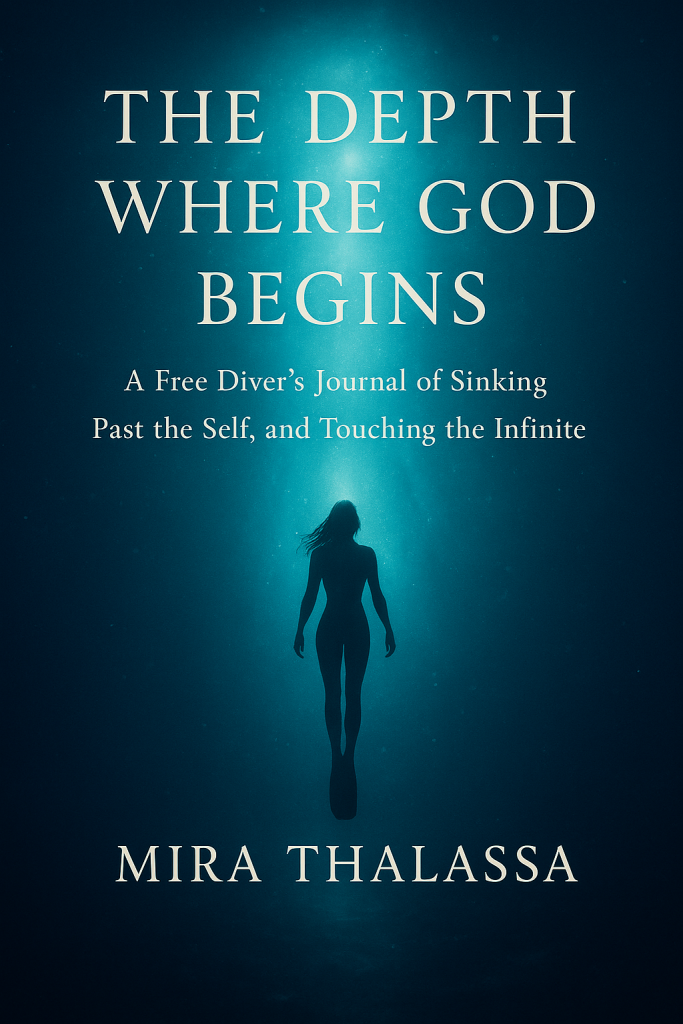
Day 1, The Descent Begins
They call me Mira Thalassa. It’s not my birth name, but it feels truer than the one I was given on land. I adopted it after my first blackout dive years ago, when the ocean took my breath, then gave it back with a whisper. Mira means “to see,” and Thalassa means “the sea.” Together they remind me that vision isn’t always sight, and that water has a way of unmaking everything false. When I walk into the surf now, I feel the pull of memory, not from this life, but older ones. My blood recognizes its source.
The world above the surface feels brittle. Every conversation feels like language trying to imitate meaning. But underwater, meaning doesn’t need words. It hums through the bones, through the pulse. When I slip beneath, I leave behind gravity and gossip. There is only breath, heartbeat, descent.
Today I practiced static breath holds in shallow water. My instructor says to imagine filling the belly, not the chest, but for me it’s more than a technique, it’s devotion. Each breath is a small act of faith, an offering to something I don’t fully understand. Sometimes, I think the ocean is watching me as much as I am studying her.
When I close my eyes, the water becomes endless blue thought. I can feel the pressure begin to wrap around me, a gentle but insistent lover, reminding me of her power. It’s not cruel, just honest. I suppose that’s what draws me to her: she has no lies.
Tonight, as I write by lamplight in my small cabin near the shore, I feel her even now, in the sound of the waves slapping the hulls outside. I know that to most, she’s a body of water. To me, she’s consciousness itself, vast, reflective, unknowable. Tomorrow I begin my deeper dives. My only prayer is that she finds me worthy to listen.
Day 5, The Body as Vessel
The first thing the sea teaches is humility. Every descent begins with control, lungs full, mind steady, and ends with surrender. I’ve learned to stop fighting that surrender. The body is not a cage. It’s a vessel. It carries what is borrowed and returns what is due. Each breath I take on the surface feels more fragile now, precious in its temporary ownership.
This morning, the water was glassy. The sun had not yet broken the horizon, and the surface reflected the moon in soft silver. I dove before breakfast, before thought. My body slid through the blue like an arrow through silk. At fifteen meters, I could hear my heartbeat, slow, echoing, a second clock ticking in the deep.
There’s a point where pressure becomes company. The compression of the lungs, the squeeze on the mask, the ringing in the ears, they’re not enemies. They’re reminders that I’m still alive, still moving between worlds. My instructor calls this “The dance with depth.” For me, it’s closer to prayer. Every contraction is the ocean reminding me that life wants to rise even as I fall.
When I surfaced, I lay floating, eyes closed, the morning light bleeding into red through my lids. I could feel warmth from above and salt from below, two kinds of love meeting at my skin. For a moment, I was not sure where air ended and water began.
Later, drying my gear, I realized that free diving is not about holding one’s breath. It’s about learning how to breathe through everything that isn’t air, through silence, through fear, through truth.
Day 11, The Mirror and the Current
I’ve stopped counting my meters. Somewhere beyond seventy, the numbers blur into sensation. What matters isn’t depth but honesty. The deeper I go, the less I can pretend. The sea shows everything. She mirrors back not the body but the soul, stretched, shivering, illuminated.
Today I saw my reflection in the shimmer above me, distorted, rippled. My face was unrecognizable, almost holy in its strangeness. I realized I am no longer diving into water. I am diving into myself. The current doesn’t resist; it receives. It pulls at my wetsuit like a mother’s hand on a child’s shoulder, tender, but instructive.
At that depth, color vanishes. Red is the first to go, then orange, then yellow. The world turns to twilight. I thought this would feel like loss, but it feels like truth. In darkness, I stop performing. My thoughts quiet. I am reduced to rhythm, inhale, kick, equalize. The body becomes instrument. The ocean plays me like a low, continuous chord.
When I surfaced, I gasped like I was being born again. My lungs felt scorched, my limbs trembled, but I was laughing. My dive partner thought I’d gone delirious. I tried to tell her that something inside me had cracked open, but how do you explain to someone that you’ve met yourself at the bottom of the world and found peace?
That night, I looked at my reflection in the windowpane. I swear, for a moment, the glass shimmered like water, and the woman looking back at me wasn’t entirely human.
Day 15, The Cocoon
Today I didn’t chase a number. I floated. Weightless, thoughtless, I allowed the sea to hold me. It felt like being cradled in the lungs of the planet. Everything slowed, heart, thought, time.
The stillness was so complete that I began to hear things inside myself. The creak of joints, the echo of blood, even the small shift of my tongue against my teeth. I understood then that silence isn’t absence; it’s an orchestra too vast for ears. The water doesn’t mute sound, it transforms it.
For an hour, I stayed near neutral buoyancy, suspended like a seed in amniotic light. It was there, in that motionless hour, that I understood the meaning of transformation. We think change happens in motion, but sometimes it happens in waiting, in surrender, in stillness, in the cocoon.
I imagined all the versions of myself dissolving, the competitor, the daughter, the wanderer, each shedding like a layer of salt on my skin. When I finally ascended, I felt lighter, not because I was rising, but because I had less of me to carry.
The horizon was gold when I broke through. For a second, I again forgot where the sky ended and the water began. Maybe that’s what enlightenment really is, not a light above, but a dissolving of boundaries.
Day 21, Revelation
It happened today. The sea opened. I descended past one hundred meters, where the world becomes blue fire. Pressure no longer hurt. It became language. Every nerve hummed with understanding. I didn’t see God as a figure, I felt God as warmth, a radiance that lived inside the pressure itself.
I remember closing my eyes and no longer knowing where I was. My mind went blank, but not empty. It was filled with the sound of my own pulse merging with the ocean’s rhythm. I understood, in that moment, what the ancients meant by surrender. To yield is not to give up. It is to align with something larger than choice.
The light came not from above but from within. It rose through me like memory, ancient and feminine. I saw faces, not literal ones, but impressions, women, ancestors, sea creatures, all blending into one vast consciousness that felt both tender and infinite.
I think I touched something beyond time. I cannot prove it, but it felt as though I had crossed the threshold where individuality ends and being begins. There was no Mira, no diver, no ocean, only breathless unity.
When I returned to the surface, my safety team said I was under too long. But I wasn’t gone. I was finally home.
Day 25, Becoming Light
Ever since the revelation dive, I feel translucent. The air feels thick, like I’m still underwater. I walk through the world slower, deliberate. Even my voice sounds different, as if it’s been rinsed clean of vanity, the endless leak of my ego.
When I dive now, I don’t descend. I dissolve. The ocean welcomes me as one of her own. I’ve stopped wearing a watch. I’ve stopped fearing the dark. I follow the light, not as something to reach, but as something to release.
I notice small things again, the way the surface dances in sunlight, the flicker of plankton like galaxies suspended in glass. It’s humbling to realize how much beauty I missed when I was searching for meaning. Now I see that beauty is meaning, raw, unfiltered, present.
I no longer measure depth in meters. I measure it in silence, in surrender, in seconds of pure being. I think that’s what enlightenment must feel like, the slow unbuttoning of self until nothing remains but breath.
Sometimes I wonder if this is what dying feels like, only without the tragedy. Just expansion. Just light.
Day 30, The Surface of Memory
I’m writing this on the shore. My gear is drying beside me. The air smells of salt and kelp and life. I should feel finished, but I don’t. The sea doesn’t end. It continues inside us. I know that now.
I look at my reflection in the tidal pool, the same eyes, but something behind them is unrecognizable. It’s not weariness. It’s recognition. I’ve seen the architecture of existence, and it looks like waves.
The ocean never once asked me to conquer her. She only ever asked me to listen. And in that listening, I found everything I had ever prayed for. The hand of God was not reaching down, it was reaching up, through water, to then through what was me.
I think I will stay by the coast a while. Teach others to dive, maybe, but not how to hold their breath. How to let go of it. How to trust the sea’s honesty.
For now, I close this journal. Not because the story is over, but because I’ve learned that the truest entries can’t be written.
They can only be lived, in the deepest of Her loving blue.
